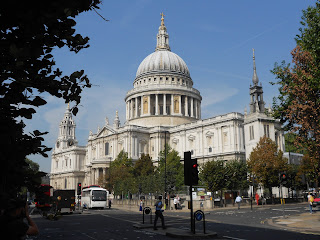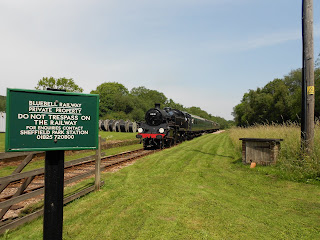We both enjoyed this wind down period after months of travelling. Whilst we were based in London, we visited some museums and archives as well as made some day trips out of town.
Day trip to York and NorthYorkshire
River scene late afternoon in York Sept 2011 Photo number 1776
Gary managed two trips to Yorkshire to further consult with various archives for his family history research. These involved a trip on the underground (tube) to Kings Cross mainline station and then a train trip up the east coast mainline railway to York and in one case on to Northallerton.
Day trip to Hampton Court Palace
We spent a day visiting Hampton Court Palace, which is set on the banks of the Thames River upstream from London. King Henry VIII's home at Hampton Court Palace was specially open for the London Open House weekend. This meant that additional parts of the palace were open to the public on that weekend. Here King Henry VIIIth ruled England and married some of his wives. The stand out on our visit was the enormous kitchen that was part of the palace. In the food preparation area there were baskets of fresh vegies for the children to handle and sort into meals. The kitchen had the largest fireplace we have ever seen. What made it special was the fireplace actually had a fire roaring in it. A supervisor was stoking the fire from the huge wood pile which was stacked along the wall in the kitchen. Nearby were the wine cellar and many dozens of wine casks (probably empty now).
Day trip to Watercress Line, Alton
Loco 34007 runs around its train after arriving at Alton Photo number 1603
Gary made a day trip to the Mid Hants preserved steam railway, otherwise known as the Watercress line. It was quite conveneient as a day trip out from our accommodation to catch a tube from Southfields to Wimbledon, then a SouthWest train to Sorbiton and change to a local train to Alton. There it is a convenient cross platform interchange to the Watercress line steam trains. The trip on the Watercress line to Alresford is quite a pleasant run even if the English summer was not good weatherwise.
Day trip to Greenwich
The boat ride from Westminister along the Thames river takes us passed the tower of London as well as the bridge. To the lovely open space of Greenwich. This is the place where time began (G.M.T.) with the Royal Observatory on the hill surrounded by parkland and along the river banks is the Naval college. We visited the 'Queens House', Greenwich, built by Queen Anne which has a most beautiful spiral staircase.
Walking tour of Bermondsley, south side of river Thames, London
London Bridge and River Thames from the south side near Bermondsley photo number 1680
W did an evening walk with about 50 other people around Bermondsley. The highlight of the walk for Gary was a visit to the Brunel museum and the chance to go down the shaft built by the Brunels as the entrance to the first tunnel under the Thames river. After the walk we travelled throught the tunnel in the London Overground underground train! This was formerly part of the East London line.
Victoria and Albert museum
It took Dorothy 3 visits to the museum before she found the official entrance to the V&A (there are numerous side entrances to the museum). The entrance is impressive. The old large entrance doorway is encircled with a wooden modern spiral. Walking through to the entrance hall where you see the old wooden panels and new style glass chandelier with combination of green/yellow lighting. This is a museum that has a bit of everything. The museum has displays of glassware, silverware, furniture and sculpture this is just a small sample of what the museum houses. Dorothy's favourite spot was the ornate afternoon tea rooms. She enjoyed a couple of visits always in time for tea and scones!
The chandelier at the V&A entrance
This room had a display of beautiful silverware
We then spent a day or so packing and throwing out all the clothing that was travel weary.
So now we are home in time to celebrate our daughters birthday and catching up with family and friends. Also coping with all the day to day dramas of life at home. We hope you have enjoyed the travel blog as we shared our experiences on our extended holiday.
The intrepid travellers in France - photo 2082
The chandelier at the V&A entrance
This room had a display of beautiful silverware
We then spent a day or so packing and throwing out all the clothing that was travel weary.
So now we are home in time to celebrate our daughters birthday and catching up with family and friends. Also coping with all the day to day dramas of life at home. We hope you have enjoyed the travel blog as we shared our experiences on our extended holiday.
The intrepid travellers in France - photo 2082




























































